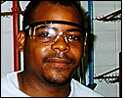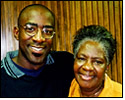By John Biewen
August 19, 1997
|
| RealAudio 2.0 14.4, RealAudio 3.0 28.8 |
Between 1940 and 1970, more than 5,000,000 African-Americans moved from the South to northern industrial cities, in what came to be known as the Great Black Migration. In recent decades, as jobs have dried up in northern cities, hundreds of thousands of blacks have moved back to the South to cities like Atlanta and Houston. But many others have moved further north. The number-one northern destination for migrating African-Americans is now Minneapolis -- a city that until recently had a tiny black population.
Audio: Plant noiseThe NiCo metal-finishing plant in South Minneapolis is clean and updated. It pays new employees $8/hour plus benefits, with no experience or education required. But company officials say they sometimes have trouble finding workers in the Twin Cities' tight labor market. Until recently, the plant's work force was mostly white. But in the past few years, NiCo has hired a number of African-Americans recently arrived from out of state. 27-year-old Steve McMorris came from Chicago four years ago. He says he couldn't support his family on a part-time job at a Chicago grocery store. Within a few months after moving to Minneapolis, he had a job at NiCo.

Steve McMorris |
McMorris: Right now I'm up to $11.25 a hour. |
Job growth in the Twin Cities is not as dramatic as the industrial boom that prompted a flood of black migration from the South to cities like Chicago and Detroit a half century ago. But unemployment in Minneapolis-St. Paul is at a rock-bottom 2.6%. Area restaurants, retailers, and manufacturing plants are festooned with "help wanted" signs.
Audio: Store ambience, musicAlton Lancaster and Ed Briggs earn $6-7/hour making sandwiches at a Subway shop in a downtown Minneapolis office building. Lancaster moved in from Chicago last spring, and Briggs came from the depressed steel town, Gary, Indiana, two years ago. Briggs says you may not get rich in Minneapolis, but there's no excuse for not finding a job in the city.Alton: What's up, partner? What can I getcha?
Customer: Six-inch tuna on whole wheat.
Briggs: If you want something, Minnesota is the place to get it, because I came up here on a Monday - I got here on a Monday night, to be exact, at 10:00. I got here, OK? And that Thursday morning at 8:00, I had two jobs.For more than a century, Minneapolis-St. Paul and its prosperity have drawn migrants - most of them white people from midwestern farms and small towns. Only since the early 1980s has the stream included a substantial number of African-Americans. Minnesota's black population has nearly tripled in less than two decades, from 50,000 in 1980 to about 140,000. By contrast, in most northern cities - New York, Chicago, Detroit, Cleveland - more blacks are moving out than are moving in. William Frey, a demographer at the University of Michigan, says Minneapolis-St. Paul emerged as a leading destination for black migrants when the downturn in the rust-belt economy deepened in the early 1980s. More than half of the African-Americans moving to Minnesota in recent years have been poor. Frey says such migration streams gain momentum through word-of-mouth.
Frey: And when you hear that this is a good place to live, and on top of it, you have some friends who live there who will make you feel welcome when you get there. It's the kind of movement that started a lot of the movement north decades ago, but this is more of a mini-trend to Minnesota; but one that will likely continue.A large fraction of blacks moving to Minnesota are coming from Chicago and Gary, Indiana, a day's drive or bus ride away. Willie Mae Sibley, now 62 years old, was in the early part of the wave, back in 1984. She says she and her husband left Chicago in search of jobs, and to get their children away from the increasing violence in the Stateway Gardens housing project.
Sibley: I had a older son - I can see it just as plain as it was the day we were walking down 35th Street - and he told me, he was walking with his arm around me and he said, "Mom, whatever you do, get these boys out of here."Sibley's husband found work in Minneapolis right away, as did several of their grown children. The family rented a house in a racially-mixed neighborhood in South Minneapolis.

Willie Mae Sibley (right) with son Terrell |
Sibley: We were blessed when we moved here, moving out of a four-bedroom house - apartment, rather - and moved to a 13-room house in Minnesota. So that was quite a change. And then living in the projects, right around the building there was no grass to walk out on, and we got a beautiful green yard to walk out on. It was quite an experience, enjoyable. |
Mrs. Sibley grew up in poverty in the Mississippi Delta. As a young woman in the 1950s, she joined the huge Northward migration of Southern blacks seeking work and a better life in the North. She and her husband worked various jobs in Chicago, but he was an alcoholic and never earned enough to lift the large family out of poverty. In Minneapolis, too, Mrs. Sibley lived on welfare for a couple of years after she and her husband separated. But she now works full-time as a pastor at a South Minneapolis ministry. Nine of her grown children live in the Twin Cities; all are in school or have jobs. Forty years after she left the South, Willie Sibley and her family are finally scratching their way into the middle class.
Sibley: I think with a black woman from the South - no education, a large family - I think I've done pretty good. Because I believe in the Lord that before this year is out I'm gonna own my own home. I'm going for that.Success stories like Willie Mae Sibley's are easy to find among blacks who've moved to Minnesota. But other kinds of stories get more attention in the local media: poor African-Americans who move to Minneapolis and remain on welfare, or get arrested for drug-dealing or homicide. In a metropolitan area that's still 90% white - and that views its quality of life as a fragile treasure - those stories feed fear. They also fuel the perception that African-Americans from the ghettos of larger cities bring problems that white newcomers do not bring.
Carlson: This is a city very close to under seige. Now it doesn't make any difference where they are from, if they are poor. But it is a poverty issue, and very, very often, it's an African-American issue.Former Minneapolis city council member and talk-radio host Barbara Carlson is running for mayor against incumbent Sharon Sayles Belton, Minneapolis's first African-American mayor. Carlson, a Republican, promises to "take back" Minneapolis and restore the city to what she considers its former greatness. She says Minnesota has been too welcoming to poor blacks from out of state, by paying some of the highest welfare benefits in the Midwest. She points to nicknames for Minneapolis that refer to its spiking homicide rate in recent years and its reputation as a welfare haven.
Carlson: We might as well be the Statue of Liberty. We are the city that's been "Murderapolis," we are the city that's been "Moneyapolis," and people don't wanna discuss it. And every time you talk about these issues you are charged with the word "racist," and I'll tell you when somebody calls you racist, all dialogue ceases. The issue is the poverty that is growing in Minneapolis today. Today! They're coming in.Mayor Sayles Belton says such talk is harmful, and paints African-American newcomers as uniformly poor and troubled.
Sayles Belton: If you looked at the growth in population amongst African-Americans in the community, the bulk of the people that are migrating in are professional people who are making contribution to the community.Twin Cities corporations have attracted thousands of black professionals since the 1960s, and continue to do so. But census data shows that since the mid-1980s, more than half of all blacks who moved to Minnesota have had incomes below the federal poverty line. By contrast, barely 10% of blacks moving to Atlanta during that period were poor.
Audio: Shelter hubbub.Many new arrivals to Minneapolis spend time here, at Hennepin County's family shelter. Surveys have found that some 60% of people in Twin Cities shelters moved to the state within the past two years. And shelter officials say more than three out of four residents are black. Besides room and board and medical treatment, families arriving at the shelter are assigned an advocate who helps them find housing in the city. Greg Owen is a sociologist with the Wilder Research Center, a St. Paul non-profit that surveys shelter residents. He says newcomers give many reasons for coming to Minnesota - jobs, better schools, safer neighborhoods - but he says the safety net is a factor for some.
Owen: Frankly, it's known outside of Minnesota that Minnesota provides a good shelter system, good housing opportunities for low-income families. And a number of the responses that we get relate to that specifically. "I thought I could get on my feet more easily here in Minnesota."But Minnesota is changing its policies toward people who move to the state. Its new welfare law, which took effect in July, pays newcomers no more than they got in the state they came from. It's too early to say whether that will slow the in-migration of poor people. One school of thought says - as welfare reform takes hold across the country, and recipients are increasingly pushed into the job market - Minnesota will draw more poor people than ever because of its abundance of low-skill jobs.
john powell (sic), a law professor and director of the Institute on Race and Poverty at the University of Minnesota, says what's striking is not that blacks are moving to the Twin Cities, but that the region remained so overwhelmingly white for so long. It's still the whitest of the nation's 15 largest metropolitan areas. powell says some white Minnesotans display a disturbing preoccupation with blacks moving to the state.
powell: And I listen to some of the talk radio shows, just incredible, incredibly fixated on Gary and Chicago. And again one would think those areas have been completely depopulated by all the hordes of black gangsters moving here from those two places.Minneapolis police say that, while most poor blacks moving to the city are not involved in crime, more than three-fourths of the city's hard-core street-gang members moved to town from Chicago. Blacks make up just 13% of Minneapolis' population, but two-thirds of the city's homicide victims and perpetrators in the past three years were black. powell says he's not interested in glossing over those facts. But he says Minnesotans should try to understand the economic despair and social isolation that created gang culture in the ghettos of Chicago and Detroit, and try to avoid replicating those conditions in Minneapolis and St. Paul. powell says so far, the Twin Cities aren't responding well. He points to the high rate of middle-class flight to the suburbs, and to studies showing housing discrimination against blacks is common in Minneapolis' middle-class neighborhoods.
powell: We manufacture despair here. And then we use that despair, we use that hopelessness, to push people further down. We say they're behaving badly, so we don't want them in our neighborhood. We isolate them even more, and then we get this vicious cycle.powell says the Twin Cities are an important test case of whether an American city - that in some ways, is just beginning to deal with race - can do better than older, larger cities have done. The U.S. Census predicts that Minneapolis-St. Paul will remain the number one northern destination for African-Americans for the next generation.
